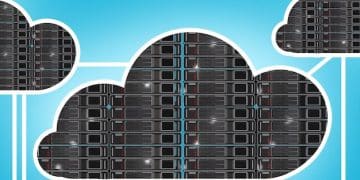Cloud Networking and Edge Computing: A Practical Guide for US Businesses

Cloud networking and edge computing offer US businesses enhanced agility, reduced latency, and improved security by distributing computing resources closer to the data source, optimizing network performance and enabling real-time processing.
Navigating the complexities of modern IT infrastructure can be challenging for US businesses. Cloud networking and edge computing: A practical guide for US businesses offers a pathway to enhanced efficiency, reduced costs, and improved performance.
Understanding Cloud Networking
Cloud networking represents a paradigm shift in how businesses manage their network infrastructure. Rather than relying solely on on-premises hardware, cloud networking leverages virtualized resources and services hosted in the cloud.
This approach offers significant advantages, including scalability, flexibility, and cost-effectiveness. By understanding the core principles of cloud networking, US businesses can make informed decisions about their IT strategies.
Benefits of Cloud Networking
Cloud networking provides numerous benefits for US businesses looking to modernize their IT infrastructure. These advantages extend beyond simple cost savings, impacting agility and innovation.
- Scalability: Easily scale network resources up or down to meet changing demands without investing in additional hardware.
- Flexibility: Quickly adapt network configurations to support new applications and services, enhancing business agility.
- Cost Savings: Reduce capital expenditures and operational expenses by leveraging cloud-based network services.
Considering these benefits, cloud networking becomes a critical component for US businesses aiming to stay competitive in today’s fast-paced market.
In practice, cloud networking involves using various cloud-based services to manage and optimize network performance. This includes virtual routers, firewalls, and load balancers, all managed through a centralized cloud platform.
In summary, cloud networking offers US businesses a pathway to more agile, cost-effective, and scalable network infrastructure. By embracing cloud networking, businesses can focus on innovation and growth, rather than being bogged down by complex hardware management.
Exploring Edge Computing
Edge computing brings computation and data storage closer to the source of data. This approach is particularly relevant for US businesses dealing with large volumes of data or requiring real-time processing capabilities.
By processing data at the edge of the network, businesses can reduce latency, improve performance, and enhance security. Edge computing is transforming industries ranging from manufacturing to healthcare.

Use Cases for Edge Computing
Edge computing is not a one-size-fits-all solution, but it offers unique advantages in specific scenarios. Understanding these use cases can help US businesses identify opportunities to leverage edge computing effectively.
- Manufacturing: Enable real-time monitoring and control of industrial equipment to improve efficiency and reduce downtime.
- Healthcare: Facilitate remote patient monitoring and diagnostics with low latency and high reliability.
- Retail: Enhance customer experiences with personalized offers and real-time inventory management.
These use cases highlight the versatility of edge computing and its potential to transform various industries in the US.
The key to successful edge computing implementation is choosing the right edge devices and platforms. These platforms provide the necessary infrastructure and tools to deploy and manage edge applications effectively.
In closing, edge computing empowers US businesses to process data closer to the source, reducing latency and improving performance. This approach is particularly beneficial for applications requiring real-time processing and analysis.
Integrating Cloud Networking and Edge Computing
The true power of modern IT infrastructure lies in the integration of cloud networking and edge computing. By combining these two technologies, US businesses can create a hybrid environment that leverages the strengths of both.
This integration enables businesses to optimize their data processing workflows, improve application performance, and enhance security. It’s a strategic approach to future-proof IT infrastructure.
Benefits of Integrated Solutions
Integrating cloud networking and edge computing offers a synergistic effect, providing benefits that go beyond what each technology can achieve independently. These benefits include enhanced agility and cost optimization.
- Optimized Data Processing: Process data at the edge for real-time analysis and transfer only relevant insights to the cloud for long-term storage and analysis.
- Improved Application Performance: Deliver low-latency applications and services by processing data closer to the end-user.
- Enhanced Security: Implement robust security measures at the edge to protect sensitive data and prevent unauthorized access.
These advantages make integrated solutions a compelling choice for US businesses looking to optimize their IT infrastructure.
Implementing an integrated solution requires careful planning and execution. Businesses need to consider their specific needs and choose the right combination of cloud and edge technologies.
Ultimately, integrating cloud networking and edge computing empowers US businesses to create a more efficient, secure, and agile IT infrastructure. This integration is crucial for staying competitive in the digital age.
Security Considerations
Security is a paramount concern for US businesses adopting cloud networking and edge computing. These technologies introduce new security challenges that must be addressed proactively.
Implementing robust security measures is essential to protect sensitive data and prevent unauthorized access. A comprehensive security strategy should cover both cloud and edge environments.
Best Practices for Security
Securing cloud networking and edge computing environments requires a multi-layered approach. Implementing the following best practices can help US businesses mitigate security risks effectively.
Regularly audit and assess the security posture of both cloud and edge environments. Implementing these security measures will protect your environment.
- Implement strong access controls and authentication mechanisms to prevent unauthorized access.
- Encrypt sensitive data both in transit and at rest to protect it from interception and theft.
- Regularly monitor and audit security logs to detect and respond to potential threats.
By following these best practices, US businesses can enhance the security of their cloud networking and edge computing environments.

Choosing the right security tools and technologies is crucial for protecting cloud and edge environments. These tools should provide comprehensive visibility and control over security threats.
In summary, security is a critical consideration for US businesses adopting cloud networking and edge computing. By implementing robust security measures and following best practices, businesses can mitigate security risks and protect their sensitive data.
Cost Optimization Strategies
Cost optimization is a key driver for US businesses adopting cloud networking and edge computing. While these technologies offer significant benefits, it’s essential to manage costs effectively to maximize ROI.
Implementing cost optimization strategies can help businesses reduce expenses and improve financial performance. A proactive approach to cost management is crucial for realizing the full potential of these technologies.
Ways to optimize costs
Optimizing costs is an ongoing process that requires continuous monitoring and adjustment. Implementing the following practices can help US businesses achieve cost savings in the long run.
- Rightsize Resources: Ensure that cloud and edge resources are appropriately sized to meet actual demand, avoiding over-provisioning and unnecessary expenses.
- Automate Management: Automate network and application management tasks to reduce operational overhead and improve efficiency.
- Negotiate Pricing: Negotiate favorable pricing agreements with cloud and edge providers to secure the best possible rates.
By implementing these cost optimization strategies, US businesses can maximize the value of their cloud networking and edge computing investments.
Regularly tracking and analyzing costs is essential for identifying areas where further optimization is possible. A data-driven approach to cost management can help businesses make informed decisions and achieve significant savings.
In conclusion, cost optimization is a critical consideration for US businesses adopting cloud networking and edge computing. By implementing effective strategies and continuously monitoring costs, businesses can maximize their ROI and improve financial performance.
Future Trends in Cloud Networking and Edge Computing
The landscape of cloud networking and edge computing is constantly evolving. US businesses need to stay informed about the latest trends to remain competitive and capitalize on new opportunities.
Understanding future trends can help businesses make strategic decisions about their IT investments and prepare for the challenges and opportunities ahead. Innovation is the key.
Anticipating Future Trends
- The evolution of 5G technology will enhance the capabilities of edge computing by providing faster and more reliable connectivity.
- AI and machine learning will play an increasingly important role in cloud networking and edge computing, enabling intelligent automation and optimization.
- Security will continue to be a top priority, with new technologies and approaches emerging to address the evolving threat landscape.
Keeping up with future technologies is imperative for long-term business succes.
US businesses need to adapt their IT strategies to embrace these future trends and leverage them to gain a competitive advantage.
In closing, the future of cloud networking and edge computing is bright, with numerous opportunities for US businesses to innovate and grow. By staying informed and adapting to emerging trends, businesses can position themselves for long-term success.
| Key Concept | Brief Description |
|---|---|
| ☁️ Cloud Networking | Virtualized network resources hosted in the cloud, offering scalability and flexibility. |
| 🌐 Edge Computing | Processing data closer to the source, reducing latency and improving performance. |
| 🛡️ Security | Implementing robust security measures to protect sensitive data in cloud and edge environments. |
| 💰 Cost Optimization | Strategies for managing and reducing expenses related to cloud and edge resources. |
FAQ
▼
Cloud networking involves virtualized network resources hosted in the cloud, offering scalability and flexibility. It is important for US businesses because it reduces costs and enhances agility.
▼
The main benefits include reduced latency, improved performance, and enhanced security due to processing data closer to the source. This is crucial for real-time applications.
▼
Start by identifying use cases where edge computing can improve performance, then integrate with cloud networking for centralized management and analysis. It requires careful planning.
▼
Implement strong access controls, encrypt sensitive data, and regularly monitor security logs. A multi-layered approach is necessary to mitigate threats in both cloud and edge environments.
▼
Rightsize resources, automate management tasks, and negotiate pricing agreements with providers. Continuously track and analyze costs to identify areas for further savings and efficiencies.
Conclusion
Cloud networking and edge computing offer US businesses a powerful combination for modernizing their IT infrastructure. By understanding the benefits, addressing the challenges, and implementing best practices, businesses can unlock new levels of efficiency, agility, and innovation, positioning themselves for long-term success in the digital age.





